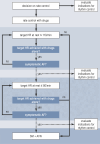Clinical Practice Guideline: Preventive Measures and Treatment Options for Atrial Fibrillation
- PMID: 40526576
- PMCID: PMC12580842
- DOI: 10.3238/arztebl.m2025.0082
Clinical Practice Guideline: Preventive Measures and Treatment Options for Atrial Fibrillation
Abstract
Background: With approximately 1.6 million people affected in Germany, atrial fibrillation (AF) is the most common arrhythmia. The management of AF, from prevention to treatment, including anticoagulation, is therefore of major clinical importance in terms of these patients' quality of life and their mortality.
Methods: This first German clinical practice guideline on AF was developed in accordance with the Regelwerk Leitlinien (rules for guidelines) of the Association of the Scientific Medical Societies in Germany (Arbeitsgemeinschaft der Wissenschaftlichen Medizi - nischen Fachgesellschaften e. V., AWMF). The available evidence on all relevant issues was retrieved by a systematic literature search and evaluated with the participation of many medical specialty societies.
Results: AF is classified on clinical grounds as paroxysmal, persis - tent, longstanding persistent, or permanent. It is associated with a 1.5- to 2-fold increase in mortality and a 4- to 5-fold increase in the risk of stroke. Nonetheless, general screening for AF is not currently recommended, as the data on this question are conflicting. Lifestyle interventions and the reduction of risk factors lessen the frequency of AF. Female sex is only a minor risk factor; the CHA2DS2-VA-Score is recommended to assess the risk of thromboembolic events. If it is 2 or higher, oral anticoagulation (OAC) is indicated, of a type that should be decided on an individual basis. In patients with cardiovascular risk factors, early rhythm control has been shown to reduce prognostically relevant cardio - vascular endpoints (3.9 versus 5.0 per 100 patientyears). Multiple studies have shown that catheter ablation is superior to drug-based antiarrhythmic therapy in patients with paroxysmal symptomatic AF as well as in those with heart failure and AF.
Conclusion: It is hoped that the recommendations contained in this guideline will lead to intensified measures for the prevention of AF, resulting in a lower prevalence of AF and its adverse sequelae. The available evidence supports the evaluation of the indications for OAC, early rhythm control, and the use of catheter ablation, especially in patients with paroxysmal AF or heart failure.
Figures




References
-
- Benjamin EJ, Muntner P, Alonso A, et al. Heart disease and stroke statistics—2019 update: A report from the American Heart Association. Circulation. 2019;139:e56–e528. - PubMed
Publication types
MeSH terms
Substances
LinkOut - more resources
Full Text Sources
Medical

